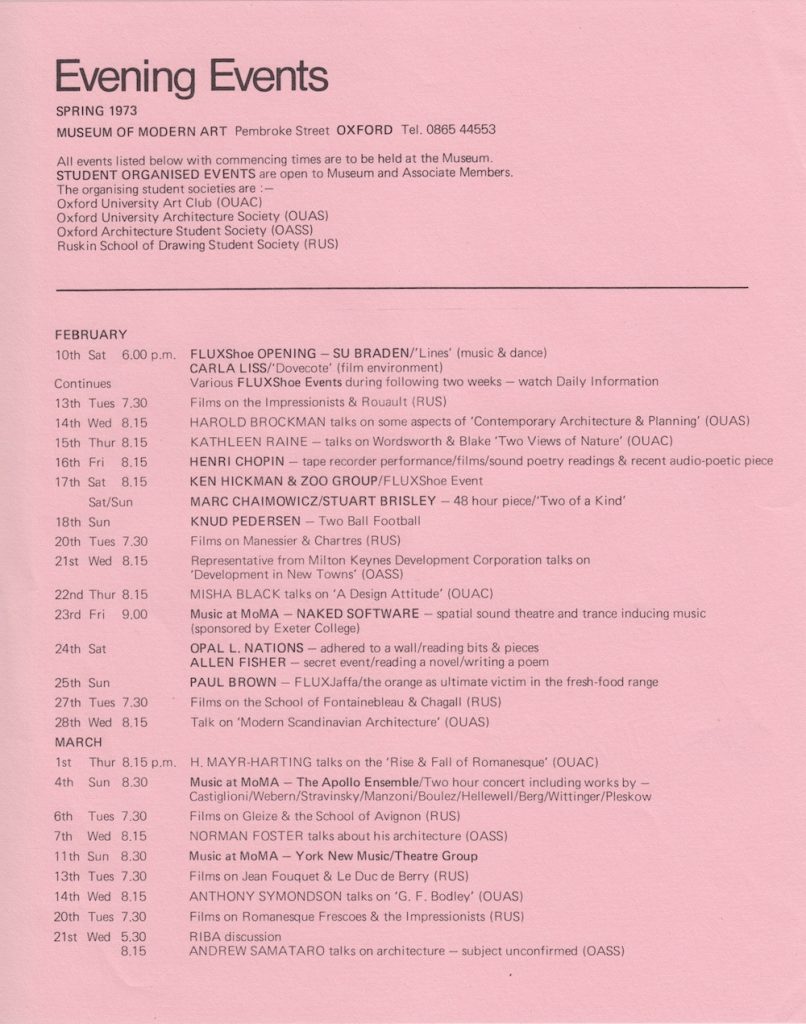FLUXSHOE, a year-long travelling exhibition, was shown at the Museum of Modern Art, Pembroke Street, and OSAC, Worcester Place, Oxford, from 10 – 25 February 1973.

FLUXSHOE began its journey around Britain in autumn 1972, with two very eventful visits to Falmouth and Exeter. After Oxford, it travelled to Edinburgh, Nottingham, Sunderland, and a few other cities. The venture was organised by David Mayor and Beau Geste Press, a community of artists living and working in Devon.
The exhibition was unique in that it was the first time the differing activities of so many artists had been brought together and made available for viewing by an English public. Nearly 100 artists contributed to FLUXSHOE, all involved in the little-known yet international movement known as Fluxus.
In the 1950s, many artists all over the world were expanding the boundaries of art: painters and sculptors wanted to explore what lay beyond the object as work of art, and composers and playwrights wanted to develop their work beyond what the formal situations of the concert-hall or the theatre could then offer.

The sort of works represented in FLUXSHOE first reached a small public in performances and publications during the early 60s, especially under the name Fluxus; artists, composers and performers were developed exciting and un-categorisable activities, sometimes strange, sometimes humorous, always stimulating.
The importance of Fluxus lay in its having been the most widespread international movement since Dada that remained alive to the Dada spirit and yet, at the same time, made significant contributions to many of the more prominent inter-media trends that still characterise contemporary art (e.g. process art, conceptualism, mail art, new modes of combining image and language, ephemerality and interaction.)
Although Fluxus flourished in many cities in Europe, the United States, and Japan, the artists involved had only rarely performed or exhibited their work in Britain (in London in 1962 and 1964, and – again in London – during the Destruction in Art Symposium at the ICA in 1966). Thus the travelling FLUXSHOE exhibition was the first major presentation of Fluxus as a whole in Britain.

FLUXSHOE, as it appeared in Oxford, presented two aspects of these interdisciplinary practices:
- A retrospective exhibit, including audio-visual materials that shows, and also documents, work done over the past decade by artists loosely associated with Fluxus.
- Presentation of contemporary works, in the shape of actions, events, performances and objects.
A truly international coterie of artists came to the UK to make special appearances at various stages of FLUXSHOE. Performances and events were different at each of these stages, dependent on who was present to contribute in person and on the unique qualities of each gallery and location. Artists included Ay-O, one of Japan’s best known printmakers, sound poet Henri Chopin, and filmmaker John Gosling.
The purpose of the travelling exhibition was not to resurrect Fluxus as it had been; to attempt that would have been both impossible and worthless. Rather, it was to present new and often participatory works within the context of Fluxus in the 1960s. From this juxtaposition, the art public in general (and art students in particular) were able to encounter the ideas and intentions of Fluxus, which remain so influential to contemporary art.

Taken from original documents in the Modern Art Oxford archive.
